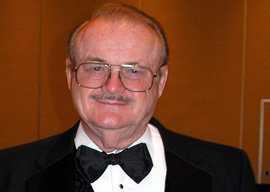
September 13, 2017

Jerry Pournelle
Source: Wikimedia Commons
Lucifer’s Hammer includes a brilliant chapter written from talk-show host Johnny Carson’s point of view as he interviews the two astronomers who discovered the approaching comet. The authors go inside Carson’s head as he figures out on the fly how to guide the scientists into making their esoteric topic fascinating to the masses in TV land. If you ever want to explain to anybody why Carson was a better interviewer than all the current hosts on late-night television, just show them these pages.
In 2011, these two novels were voted among the top 100 science-fiction and fantasy stories ever (“ever” going all the way back to Mary Shelley’s Frankenstein), in a poll of 60,000 NPR listeners.
A 1985 collaboration, Footfall, about an alien invasion, reached No. 1 on the best-seller list. James Cameron optioned the film rights and spent a week with the authors dissecting their book. Jerry spoke of the Terminator director as the ideal reader that authors dream of. Unfortunately, the glut of successful (Independence Day) and unsuccessful (Mars Attacks!) mid-1990s alien-invasion movies turned Cameron in the direction of doing Titanic instead.
A Pournelle solo project that has been kicking around in development hell more recently is Janissaries.
A military sci-fi novel, Janissaries is basically a war nerd’s fantasy about the eternal question: Who would win in a fight? For example, could a Roman legion beat a 15th-century Swiss mercenary force of pikemen? Janissaries is like Mayweather-McGregor for military-history buffs.
Why human armies of different eras are fighting is explained in detail by Jerry, an expert at coming up with surprisingly plausible explanations for whatever plot development he needed. But rather than try to cram all that story into one two-hour movie, Janissaries might work better as an open-ended TV show in which each episode could highlight a new battle, such as Genghis Khan’s cavalry vs. Henry V’s longbow men.
In 1977 Jerry paid $12,000 to have a state-of-the-art personal computer assembled for him, supposedly to boost his productivity. By 1980 that led to his long-running “Chaos Manor” column in Byte magazine in which he would document his troubles on the bleeding edge of PC technology. As fellow word-processing aficionado Dave Barry explained jealously, Jerry got paid to mess around with his computers when he should be writing:
Every month, his column has basically the same plot, which is:
1. Jerry tries to make some seemingly simple change to one of his computers, such as connect it to a new printer.
2. Everything goes hideously wrong…. Sometimes there are massive power outages all over the West Coast. Poor Jerry spends days trying to get everything straightened out.
3. Finally…Jerry gets his computer working again approximately the way it used to, and he writes several thousand words about it for ‘Byte.’
I swear it’s virtually the same plot, month after month, and yet it’s a popular column in a magazine that appeals primarily to knowledgeable computer people.
I like to imagine Steve Jobs circulating “Chaos Manor” columns to his executives with scribbled annotations suggesting that some people would pay good money to not have to go through all this.
The SoCal sci-fi crowd finally had a simpatico president with the election in 1980 of Ronald Reagan, who later reflected at the United Nations:
I occasionally think how quickly our differences worldwide would vanish if we were facing an alien threat from outside this world.
With his sincerity and high-mindedness, Reagan’s William Shatner-level acting abilities would have been ideal for science-fiction roles. But there weren’t enough of them yet. Instead, having to compete with the extraordinary charisma of Humphrey Bogart for the leads in Casablanca and The Treasure of Sierra Madre proved a losing proposition, and Reagan was forced to find a second career.
In the early 1980s, Pournelle (who had written speeches for Reagan when he was governor of California), Heinlein, Poul Anderson, and other sci-fi authors, along with heavyweight scientists such as artificial-intelligence pioneers John McCarthy and Marvin Minsky and physicist Freeman Dyson, began assembling at Niven’s house in the San Fernando Valley to think big thoughts, such as space-based missile defense.
Did Pournelle and his friends help inspire the 1983 Strategic Defense Initiative? And did Reagan’s Star Wars plan frighten the politburo into their catastrophic choice of Mikhail Gorbachev, leading to America’s sudden victory in the Cold War?
Historians will argue.
But the notion that Reagan, who was called Ronnie Raygun by his detractors, would be influenced by sci-fi writers hardly seems implausible. After all, Gorbachev revealed in 2009 that at their first summit conference in 1985, Reagan asked him to step outside and then inquired:
“‘What would you do if the United States were suddenly attacked by someone from outer space? Would you help us?’”
“I said, ‘No doubt about it.’”
“He said, ‘We too.’”
And that, as Reagan would have said at the end of the movie if he’d gotten the lead in Everybody Comes to Rick’s, was the beginning of a beautiful friendship.
Having Jerry for a friend since 1999 was a beautiful experience as well.